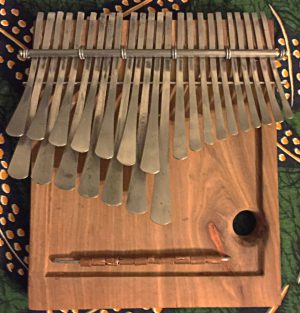This page includes a video that shows you techniques for tuning your mbira, tuning advice, and recordings of a few common tunings.
The mbira being tuned in the video is an MBIRA workshop pitch – around B – Nyamaropa tuning mbira. For other tunings, you can use the same techniques, but tune to the recording of your tuning, below.
Key things to remember when tuning your mbira are:
- When the key is longer, it is lower in pitch. When it is shorter, it is higher in pitch. This refers to the length of the key beyond the bar underneath the keys.
- When a key is loose, tap it toward the top of the board until it comes loose, then use long nose pliers to bend it down as close as possible to where it usually goes underneath the top bar over the keys. Now, tap it back into position, until the octave relationships are correct. It should no longer be loose, as the slight bend you made will hold it tightly under the top bar. On an mbira with wired (as vs bolted) construction, bend the key cautiously when tightening a key, so you don’t stretch the wire and make many more keys loose!
- Helpful tuning tools are a tabla hammer (brass, from India, with very pointed tip), a pair of long-nose pliers, a small screwdriver, and a small block of hardwood. A regular hammer can be used together with a nailset, instead of a tabla hammer, but don’t use it directly on the playing end of the key.
- Use the Mbira Octave Relationships chart when tuning.
Recordings of several common tunings
In Zimbabwe, almost every village has a different mbira tuning, but here are recordings of a few tunings that are sold on this website. Note that giving names to tunings is a relatively new development for the international market, as a village previously had no need to name the tuning that was the only one played there!
These recordings have each note played 4 times. First played are the upper left hand row, from the middle of the mbira to the outer left. Then the lower left keys are played from the outer left of the mbira to the center. Finally the right side keys are played, from the center of the mbira to the outer right side.
Nyamaropa tuning
Nyamaropa tuning is by far the most common mbira tuning in Zimbabwe. The intervals are usually similar to Mixolydian mode, though not exactly except in G Nyamaropa mbiras.
1. MBIRA workshop pitch (around B) Nyamaropa tuning:
2. G pitch Nyamaropa tuning:
3. Magaya “standard” Nyamaropa tuning (pitch around B flat):
4. “Medium low” Nyamaropa tuning (pitch around G#):
5. A pitch Nyamaropa tuning:
6. Musekiwa Nyamaropa tuning (pitch around B flat)
Mavembe, also known as Gandanga, tuning
Mavembe, also known as Gandanga, tuning is also found in various pitches, so this recording is of the pitch currently sold on this website (pitch around A). The intervals are similar to Phrygian mode:
Nemakonde tuning
Low pitched mavembe tuning mbiras are referred to as Nemakonde, and very low ones we call Bass Nemakonde.
1. Nemakonde tuning (pitch around F):
2. Bass nemakonde (pitch around C#):
Dambatsoko tuning
Dambatsoko is the low pitched tuning played by the Mujuru family, and is close to a major scale, but not exactly. Pitch around E:
Katsanzaira tuning
Katsanzaira is a sweet high pitched tuning with intervals similar to Dorian mode. Pitch around Eb:
Mazingizi tuning
Mazingizi tuning is exactly an octave lower than Katsanzaira tuning, and can be played together with it. Similar to Dorian mode, pitch around low Eb:
Saungweme tuning
Saungweme is a funky non-Western sounding tuning played by Rinos ‘Simboti’ Mukuwurirwa. It is somewhere between nyamaropa tuning and a whole tone scale. Pitch around B. Simboti introduces the tuning and plays the keys in a different order than our other tuning recordings, one time each:
Dongonda tunings
Dongonda tuning mbiras are one of the above tunings, but with the right hand keys an octave lower (except the lowest right thumb note). Tune the left hand keys, and lowest right thumb key, to the appropriate recording above. Then use the Mbira Octave Relationships chart to tune the right hand keys to match the left hand keys.
Dindinyongwe tuning
Dindinyongwe tuning has intervals similar to Locrian mode. Pitch is about G#.
Nyunganyunga, also known as Karimba
This 15-key instrument was developed in the 1960’s as a curriculum instrument for children in Zimbabwean schools, because it is not a traditional instrument used in ceremonies, thus avoiding issues of religious or tribal preference. This recording is of an F pitch nyunganyunga mbira:

